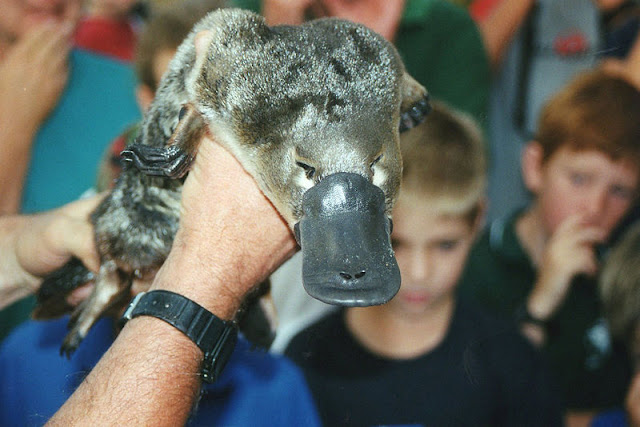The platypus (Ornithorhynchus anatinus) is a rare animal. The bizarre appearance of this duck-billed, beaver-tailed, and otter-furred mammal baffled the scientists when they first examined it. Even they thought that it’s just an elaborate fraud. The platypus is an endemic to eastern Australia and this mammal is one of two mammals that lay eggs instead of giving birth to live young. The males are also venomous. The sharp stingers on the heels of their rear feet are used to deliver a strong toxic that cause severe pain to humans. The platypuses have 3 lbs (1.4 kg) in weight and about 50 cm (20 in) length from head to tail.
Platypuses are great swimmer and spend much of its time in the water foraging for food. They used their front webbed feet for paddling and their hind feet and beaverlike tail for steering. Their eyes and ears were covered with folds of skin to prevent water from entering, and the nostrils close with watertight seal. A platypus can remain submerged for a minute or two.
They hunt underwater. With their sensitive bill, they scoop up insects and larvae, selfish, and worms along with bits of gravel and mud from the bottom. They stored all this material in cheek pouches and, at the surface, mashed for consumption. Platypuses don’t have teeth, so the bits of gravel help them to digest their meal. When platypuses on land, the webbing on their feet retracts to expose individual nails and allow them to run.
The platypus lives in a simple ground burrow whose entrance is about 30 cm (12 in) above the water level. Females lay their eggs inside one of the burrow’s chamber. The female constructs a deeper, more elaborate burrow up to 20 m (66 ft) long and blocked at intervals with plugs, which may act as a safeguard against rising waters or predators, or as a method of regulating humidity and temperature. The eggs hatch in about ten days. The newly hatched young are vulnerable, blind, and hairless, and are fed by the mother's milk. Females nurse their young for three to four months until the babies can swim on their own.
Sources: National Geographic, Wikipedia
Recent Posts
Tags
Funny Animals
Animal Videos
Funny Videos
Animal Pictures
Dogs
So cute
Cats
Gifs
Baby Animals
Amazing Animals
Funny Cats
Funny Animal Gifs
Cute dogs
Puppy
Kitten
Funny animals of the week
Pets
Birds
Friendship
Elephants
Funny Animal Captions
Wildlife
Captions
Goats
Meme
Animal Love
Bears
Ducks
Bunnies
Lions
Pandas
Beautiful Creatures
Otters
Parrots
Interspecies Friends
Horses
Monkey
Pigs
Hamsters
Squirrel
Rabbits
Animal Facts
Animal News
Tigers
Foxes
Penguins
Polar Bears
Raccoons
Chickens
Crows
Dolphins
Hedgehogs
Cows
Seals
Ferrets
Owls
Fish
Kangaroos
Red Pandas
Snakes
Lambs
Mouse
Cockatoo
Gorillas
Octopus
Sheep
Deers
Goose
Koalas
Rhinos
Sea Lions
Turtles
Cheetah
Deer
Giraffe
Leopards
Tortoises
Chimpanzee
Cockatiel
Porcupines
Rats
Wolves
Alligators
Crabs
Crocodiles
Guinea Pigs
Orangutan
Pigeons
Chinchillas
Donkeys
Grizzly Bears
Insects
Jaguars
Lemurs
Meerkats
Skunks
Spiders
Hippos
Lizards
Micro pigs
Mini Pigs
Parakeets
Seagulls
Sharks
Sloths
Bearded Dragons
Black Bear
Butterflies
Camels
Chameleons
Chipmunks
Eagles
Emus
Fennec Foxes
Ostrich
Praying Mantises
Sea Otters
Wombats
Alpaca
Armadillos
Baboons
Frogs
Humpback Whales
Impalas
Killer Whales
Llamas
Lovebirds
Macaw
Pony
Prairie Dog
Ravens
Whales
Anteaters
Antelopes
Ants
Bald Eagles
Bats
Buffaloes
Capuchin Monkeys
Elephant Seal
Elk
Flamingos
Hawks
Hummingbirds
Iguanas
Opossum
Peacocks
Pelican
Python
Raccoon
Ram
Red Fox
Stoats
Sugar Gliders
Weasels
Arctic Fox
Beavers
Bees
Bengal Cats
Bison
Black Swan
Budgies
Bulls
Bumble Bee
Caiman
Chicks
Goliath Grouper
Ground Squirrel
Groundhogs
Hermit Crab
Honey Badgers
How to...
Hyenas
Infographic
Jumping Spiders
Lorikeet
Lynx
Manatees
Mantis
Minks
Moose
Mountain Lions
Orcas
Pangolin
Possums
River Otter
Slow Loris
Snail
Starfish
Stingrays
Swans
Turkeys
Wallaby
Walrus
Warthogs
Wasps
Albatross
American Woodcock
Anglefish
Animals
Ankole-Watusi
Blanket Octopus
Blue Heron
Bobcats
Bonobo
Budgerigar
Bugs
Bull Elk
Burrowing Owls
Capybara
Chihuahua
Clark's Grebes
Condor
Coyote
Crayfishes
Doves
Dragonflies
Eel
Electric Eel
Endangered Animals
Falcons
Fin Whales
Foals
Geckos
Gibbons
Gnu
Green Heron
Hercules beetle
Heron
Hognose
Honey Bees
Horned Puffin
Husky
Jellyfish
Kestrel
Kestrel Falcon
Koi
Kookaburra
Ladybugs
Leatherjacket
Liliger
Lobsters
Locust
Lyrebirds
Mahi-mahi
Marmosets
Mini Horse
Moles
Mongoose
Moorhens
Myna
Narwhals
Oarfish
Ocelots
PSAs
Pallas's Cat
Piranhas
Pit Bull
Platypus
Porpoises
Pygmy Marmoset
Quail
Rare Animals
Red Tail Hawk
Sloth Bears
Sperm Whales
Swallows
Tarantulas
Tiger Shark
Toad
Toucans
Uromastyx
Vicuñas
Western Grebes
Whale Sharks
White Deer
White Lion
Wild Dogs
Wildebeest
Wolverine
Zebras














I live in Australia and spent sometime in Canberra (the capital with 300,000 people) and on the outskirts of the city you could actually see platypusses! While they were a rare sight, it shows how much housing developments are affecting their habitat. They are now close to being endangered because of their low breeding rate and loss of environment. It would be sad to lose this creature forever ...
ReplyDelete